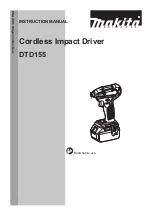
5
For socket with O-ring and pin
Move the O-ring out of the groove in the socket and
remove the pin from the socket. Fit the socket onto the
anvil of the tool so that the hole in the socket is aligned
with the hole in the anvil. Insert the pin through the hole
in the socket and anvil. Then return the O-ring to the
original position in the socket groove to retain the pin.
To remove the socket, follow the installation procedures
in reverse.
Fig.4
Hook
The hook is convenient for temporarily hanging the tool.
This can be removed without using a tool. This can be
installed on either side of the tool.
Installing and removing hook
Fig.5
Expand the upper part of the hook in both directions and
remove it. To install the hook, follow the removal
procedure in reverse.
OPERATION
CAUTION:
•
Always hold the tool only by the handle when
performing an operation. Do not touch the metal
part.
Fig.6
The proper fastening torque may differ depending upon
the kind or size of the bolt, the material of the workpiece
to be fastened, etc. The relation between fastening
torque and fastening time is shown in the figures.
200
180
160
140
120
100
80
60
40
20
0
1
2
3
4
M10
M12
M16
M16X80
M12X80
M10X80
Standard bolt
Fastening torque (N m)
Fastening time (S)
.
004238
200
180
160
140
120
100
80
60
40
20
0
1
2
3
4
5
M10
M12
M12X80
M10X80
High tensile bolt
Fastening torque(N m)
Fastening time (S)
.
004239
Hold the tool firmly and place the socket over the bolt or
nut. Turn the tool on and fasten for the proper fastening
time.
NOTE:
•
When fastening screw M10 or smaller, carefully
adjust pressure on the switch so that the screw is
not damaged.
•
Hold the tool pointed straight at the bolt or nut
without applying excessive pressure on the tool.
•
If you fasten the bolt for a time longer than shown
in the figures, the bolt or the socket may be
overstressed, damaged, etc. Before starting your
job, always perform a test operation to determine
the proper fastening time for your bolt. Especially
for the bolt over than M10, perform the above test
operation to prevent the trouble on socket or bolt,
etc.
The fastening torque is affected by a wide variety of
factors including the following. After fastening, always
check the torque with a torque wrench.
1. Voltage
•
Voltage drop will cause a reduction in the
fastening torque.
2. Socket
•
Failure to use the correct size socket will
cause a reduction in the fastening torque.
•
A worn socket (wear on the hex end or square
end) will cause a reduction in the fastening
torque.
3. Bolt
•
Even though the torque coefficient and the
class of bolt are the same, the proper
fastening torque will differ according to the
diameter of bolt.
•
Even though the diameters of bolts are the
same, the proper fastening torque will differ
according to the torque coefficient, the class
of bolt and the bolt length.






































